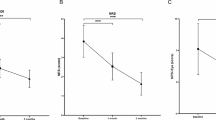Abstract
Purpose
To investigate the effects of topical autologous serum application on the ocular surface in patients with toxic corneal epitheliopathy induced by anti-glaucoma drugs.
Methods
The patients who had corneal epitheliopathy because of preservative-containing anti-glaucoma eye drops were prospectively enrolled. The epitheliopathy was refractory to preservative-free artificial tear treatment. The patients topically applied 20% autologous serum to the eye eight times per day for 1 month. Baseline and one-month change in symptoms and signs were assessed by the Ocular Surface Disease Index (OSDI) questionnaire, tear film break-up time (TFBUT), Schirmer I values, corneoconjunctival staining scores, corneal sensitivity, InflammaDry® tear immunoassay, and tear cytokine profiles using a bead-based multiplex assay.
Results
A total of ten consecutive patients were enrolled between January and August 2018 and evaluated after one-month treatment with 20% autologous serum eye drops. Significant improvement was observed in symptoms (OSDI scores from 25.5 ± 20.9 to 10.5 ± 12.0; P = .039), TFBUT (from 3.1 ± 1.8 s to 5.4 ± 2.3 s; P = .025), corneoconjunctival staining scores (from 7.7 ± 1.8 to 1.8 ± 1.9 NEI scale; P = .005), corneal sensitivity (from 4.6 ± .9 cm to 5.8 ± .5 cm; P = .013), and metalloproteinase-9 levels (P = .013). There were no significant changes in Schirmer I values and tear cytokine levels on multiplex assays. Treatment-related side effects were not detected.
Conclusions
Topical instillation of 20% autologous serum is an effective treatment for toxic corneal epitheliopathy associated with anti-glaucoma eye drops.
Trial registration number
KCT0003827.


Similar content being viewed by others
References
Aguayo Bonniard A, Yeung JY, Chan CC, Birt CM (2016) Ocular surface toxicity from glaucoma topical medications and associated preservatives such as benzalkonium chloride (BAK). Expert Opin Drug Metab Toxicol 12:1279–1289. https://doi.org/10.1080/17425255.2016.1209481
Perez-Bartolome F, Martinez-de-la-Casa JM, Arriola-Villalobos P, Fernandez-Perez C, Polo V, Garcia-Feijoo J (2017) Ocular surface disease in patients under topical treatment for glaucoma. Eur J Ophthalmol 27:694–704. https://doi.org/10.5301/ejo.5000977
Anwar Z, Wellik SR, Galor A (2013) Glaucoma therapy and ocular surface disease: current literature and recommendations. Curr Opin Ophthalmol 24:136–143. https://doi.org/10.1097/ICU.0b013e32835c8aba
Geerling G, Maclennan S, Hartwig D (2004) Autologous serum eye drops for ocular surface disorders. Br J Ophthalmol 88:1467–1474. https://doi.org/10.1136/bjo.2004.044347
Rauz S, Koay SY, Foot B, Kaye SB, Figueiredo F, Burdon MA, Dancey E, Chandrasekar A, Lomas R (2018) The Royal College of Ophthalmologists guidelines on serum eye drops for the treatment of severe ocular surface disease: executive summary. Eye 32:44–48. https://doi.org/10.1038/eye.2017.208
Moon J, Ko JH, Yoon CH, Kim MK, Oh JY (2018) Effects of 20% human serum on corneal epithelial toxicity induced by benzalkonium chloride: in vitro and clinical studies. Cornea 37:617–623. https://doi.org/10.1097/ICO.0000000000001475
Lemp MA (1995) Report of the National Eye Institute/Industry workshop on clinical trials in dry eyes. CLAO J 21:221–232
Park JY, Kim BG, Kim JS, Hwang JH (2018) Matrix metalloproteinase 9 point-of-care immunoassay result predicts response to topical cyclosporine treatment in dry eye disease. Transl Vis Sci Technol 7:31. https://doi.org/10.1167/tvst.7.5.31
Kaufman HE (2013) The practical detection of mmp-9 diagnoses ocular surface disease and may help prevent its complications. Cornea 32:211–216. https://doi.org/10.1097/ICO.0b013e3182541e9a
Oh JY, Choi H, Lee RH, Roddy GW, Ylostalo JH, Wawrousek E, Prockop DJ (2012) Identification of the HSPB4/TLR2/NF-kappaB axis in macrophage as a therapeutic target for sterile inflammation of the cornea. EMBO Mol Med 4:435–448. https://doi.org/10.1002/emmm.201200221
Sarkar J, Chaudhary S, Namavari A, Ozturk O, Chang JH, Yco L, Sonawane S, Khanolkar V, Hallak J, Jain S (2012) Corneal neurotoxicity due to topical benzalkonium chloride. Invest Ophthalmol Vis Sci 53:1792–1802. https://doi.org/10.1167/iovs.11-8775
Chen W, Zhang Z, Hu J, Xie H, Pan J, Dong N, Liu Z (2013) Changes in rabbit corneal innervation induced by the topical application of benzalkonium chloride. Cornea 32:1599–1606. https://doi.org/10.1097/ICO.0b013e3182a8196f
Semeraro F, Forbice E, Nascimbeni G, Taglietti M, Romano V, Guerra G, Costagliola C (2016) Effect of autologous serum eye drops in patients with sjogren syndrome-related dry eye: clinical and in vivo confocal microscopy evaluation of the ocular surface. In Vivo 30:931–938
Bradley JC, Simoni J, Bradley RH, McCartney DL, Brown SM (2009) Time- and temperature-dependent stability of growth factor peptides in human autologous serum eye drops. Cornea 28:200–205. https://doi.org/10.1097/ICO.0b013e318186321e
Hussain M, Shtein RM, Sugar A, Soong HK, Woodward MA, DeLoss K, Mian SI (2014) Long-term use of autologous serum 50% eye drops for the treatment of dry eye disease. Cornea 33:1245–1251. https://doi.org/10.1097/ICO.0000000000000271
Ziakas NG, Boboridis KG, Terzidou C, Naoumidi TL, Mikropoulos D, Georgiadou EN, Georgiadis NS (2010) Long-term follow up of autologous serum treatment for recurrent corneal erosions. Clin Exp Ophthalmol 38:683–687. https://doi.org/10.1111/j.1442-9071.2010.02304.x
Funding
This research was supported by the National Research Foundation of Korea (NRF) grant funded by the Korea government (MSIT) (No. 2018R1A2B2004108).
Author information
Authors and Affiliations
Corresponding author
Ethics declarations
Conflict of interest
All authors have no conflict of interest.
Ethical approval
This study was approved by the Institutional Review Board of Seoul National University Hospital (No. 1705-086-855). All procedures performed in studies involving human participants were in accordance with the ethical standards of the institutional and/or national research committee and with the 1964 Helsinki Declaration and its later amendments or comparable ethical standards. The study was retrospectively registered on Clinical Research Information Service (CRiS), Republic of Korea (Trial registration number: KCT0003827) on 19/04/2019. The first registration date was 11/04/2018.
Informed consent
Informed consent was obtained from all individual participants included in the study.
Additional information
Publisher's Note
Springer Nature remains neutral with regard to jurisdictional claims in published maps and institutional affiliations.
Rights and permissions
About this article
Cite this article
Yoon, C.H., Lee, H.J., Park, H.Y. et al. Effects of topical autologous serum on the ocular surface in patients with toxic corneal epitheliopathy induced by anti-glaucoma drugs. Int Ophthalmol 40, 547–552 (2020). https://doi.org/10.1007/s10792-019-01211-8
Received:
Accepted:
Published:
Issue Date:
DOI: https://doi.org/10.1007/s10792-019-01211-8




